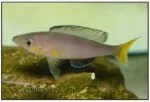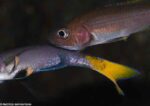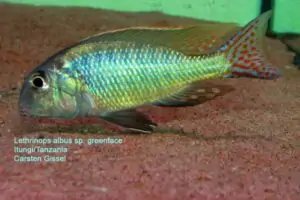Cyprichromis leptosoma description
Cyprichromis leptosoma is a peaceful schooling fish, they can easily be combined with other cichlids from Lake Tanganyika. They swim in the upper part of the aquarium. They must be kept in a large school (more than 12 specimens) and the aquarium must be well covered as they are good jumpers. A further condition is sufficient free swimming space. The schools resemble those of herring, hence they are also called herring cichlids.
Cyprichromis leptosoma comes in many varieties, including:
- Malasa
- Utinta
- Kitumba
- Tri-color
- Bulu-point
- Mpimbwe
yprichromis leptosoma is not to be confused with Cyprichromis sp. “leptosoma jumbo” , a yet undescribed species that grows considerably larger.
Synonyms: Paratilapia leptosoma, Limnochromis leptosoma.
Diet
In the wild the Cyprichromis leptosoma feeds on small live food that floats in the water column and insect larvae. In the aquarium you can feed them with small live or frozen food interspersed with flake food or granules. Make sure that the food does not sink too quickly because they only eat sinking or floating food.
The Aquarium
Only swimming space is important for this herring cichlid. Males make a three-dimensional territory in the open water. They chase away other males who swim into their territory. Because they are schooling fish, a spacious aquarium of at least 180 centimeters in length is recommended. With this minimum size, I would keep no more than 3 males and 8 females.
As usual for Tanganyika cichlids, the temperature of the water can be between 24 and 26 degrees. The pH in the lake is quite high with a pH of 8.5 to 9 and a GH of 7 to 11.
Breeding Cyprichromis leptosoma
Breeding Cyprichromis leptosoma is not too difficult. They lay the eggs in midwater just below the surface. The female catches the eggs and while the male fertilizes them. The female broods on the eggs inside her mouth. After 3 weeks the fry leave the female’s mouth and have to take care of their own from now on. The fry stay in the upper water layers and are left alone by the parents.
You can feed the fry with newly hatched brine shrimp and other small live food. They will also take crushed flakes.
Video
Author
John de Lange
Copyright images
J. de Lange
Matthijs Meindertsma
Sue – Suephotos.com (original website no longer available)













Reviews
There are no reviews yet.